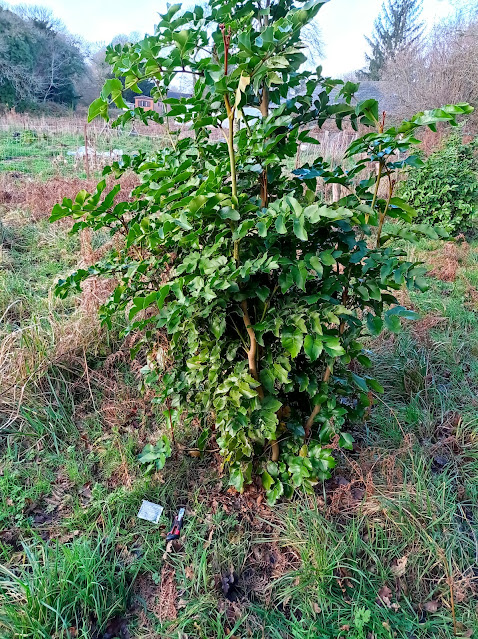The sorbopyrus mystery. I recently became aware of someone saying he thought shipova and tatarka were the same. I have grafted both the same year on quince c rootstock. At first glance they look like two eggs layed by the same hen but closer inspection reveals differences. One of the two is much more vigourous and the leaf shape between the two is not the same. Only when they will flower and fruit will i know for sure if they are different or not.
Here is a picture of the two grafted plants. The one on the right is much bigger than the one on the left.
All other leaves and branches lower down all belong to the plant on the right.
Look for older posts on my blog about sorbopyrus and you will also see that one plant is much bigger.
Hard to see here but the stem of the left one is much thicker. 50% thicker. At least.
And pulling away more straw reveals another branch with a bud that was covered.
The diameter of the larger plant on the left is 27mm
and the diameter of the smaller one is 19mm.
That is a huge difference in vigour.
I looked at the thickness of the stem and the difference in vigour is clearly visible. The plant on the left is much bigger than the one on the right. The plant on the left has pretty straight round edges to its leaves whereas the one on the right clearly has serrated leaves at the end.
Also the usda genebank lists 5 different accessions of sorbopyrus other than sorbopyrus auricularis.
When you search the internet for sorbopyrus fruit you come across pictures of reddish, yellow more round fruit and spherical wider than high fruit that look different. It is possible that what they list as "bulbiformis" is identical to tatarka or tatarova. If they will flower one day and make fruit i will know for sure.
Still thinking about this i went out again and took more pictures.
This might be a better picture of the ends of the leaves of the tatarka.
And the round leaves of the shipova.
I planted 6 more grafted sorbopyrus trees into a protected enclosure.
They are all grafted on to Kirchensaller rootstock so contrary to the ones on quince c these will grow huge pear trees that can live up to 200 years.
2 of them were tatarka, 2 were shipova from sweden and 2 were shipova from the south of france,
I suspect the shipova will be the same but maybe not.
Enclosure for the sorbopyrus trees
A few are not in great shape but i am happy they are all still alive.
I managed to check leaf shape on some of them and found round (shipova) and serrated (tatarka) again.
Round leaves on that shipova.
Serrated ends of leaves.
And serrated leaves again.
So it all remains very interesting and intriguing.
Anyone else who grows sorbopyrus and wants to get in touch for exchange of information and pictures please get in touch with me.





















Comments
Post a Comment